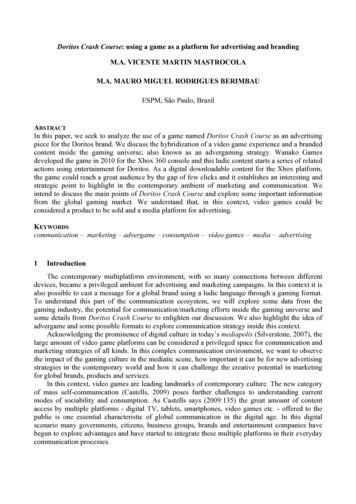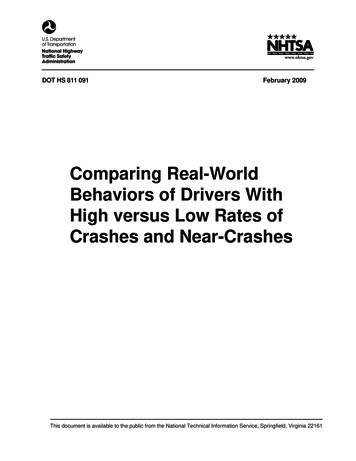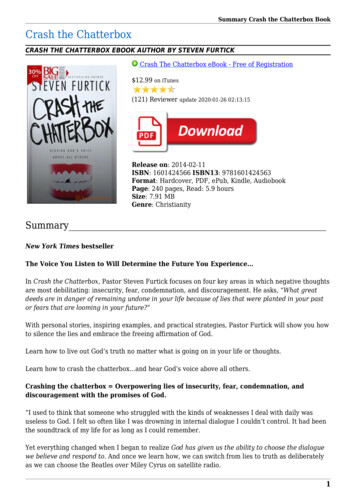
Transcription
Doritos Crash Course: using a game as a platform for advertising and brandingM.A. VICENTE MARTIN MASTROCOLAM.A. MAURO MIGUEL RODRIGUES BERIMBAUESPM, São Paulo, BrazilABSTRACTIn this paper, we seek to analyze the use of a game named Doritos Crash Course as an advertisingpiece for the Doritos brand. We discuss the hybridization of a video game experience and a brandedcontent inside the gaming universe; also known as an advergaming strategy. Wanako Gamesdeveloped the game in 2010 for the Xbox 360 console and this ludic content starts a series of relatedactions using entertainment for Doritos. As a digital downloadable content for the Xbox platform,the game could reach a great audience by the gap of few clicks and it establishes an interesting andstrategic point to highlight in the contemporary ambient of marketing and communication. Weintend to discuss the main points of Doritos Crash Course and explore some important informationfrom the global gaming market. We understand that, in this context, video games could beconsidered a product to be sold and a media platform for advertising.KEYWORDScommunication – marketing – advergame – consumption – video games – media – advertising1IntroductionThe contemporary multiplatform environment, with so many connections between differentdevices, became a privileged ambient for advertising and marketing campaigns. In this context it isalso possible to cast a message for a global brand using a ludic language through a gaming format.To understand this part of the communication ecosystem, we will explore some data from thegaming industry, the potential for communication/marketing efforts inside the gaming universe andsome details from Doritos Crash Course to enlighten our discussion. We also highlight the idea ofadvergame and some possible formats to explore communication strategy inside this context.Acknowledging the prominence of digital culture in today’s mediapolis (Silverstone, 2007), thelarge amount of video game platforms can be considered a privileged space for communication andmarketing strategies of all kinds. In this complex communication environment, we want to observethe impact of the gaming culture in the mediatic scene, how important it can be for new advertisingstrategies in the contemporary world and how it can challenge the creative potential in marketingfor global brands, products and services.In this context, video games are leading landmarks of contemporary culture. The new categoryof mass self-communication (Castells, 2009) poses further challenges to understanding currentmodes of sociability and consumption. As Castells says (2009:135) the great amount of contentaccess by multiple platforms - digital TV, tablets, smartphones, video games etc. - offered to thepublic is one essential characteristic of global communication in the digital age. In this digitalscenario many governments, citizens, business groups, brands and entertainment companies havebegun to explore advantages and have started to integrate these multiple platforms in their everydaycommunication processes.
In this text we observe and discuss the game named Doritos Crash Course, created in 2010 byWanako Games Studio for the Xbox 360 console. This game fits the casual game category that,according to Trefay and Kaufmann (2010, p.1), can be defined as games that are quick to play,accessible to players with different ability levels and with simple mechanics. In this kind of game:the rules and goals must be clear; players need to be able to quickly reach proficiency; casual gameplay must adapt itself to a player s life and schedule; and the game concepts must borrow familiarcontent and themes from life.In Doritos Crash Course, the player controls his own Xbox avatar that must run in a type offantastic roller coaster to reach the finishing point before time runs out. With rich visual graphics,the game is a fast and casual experience for all ages and already has downloadable expansions andeven earned a sequel: the Doritos Crash Course 2. The game is free for download and consists in a2.5D side-scrolling platform (essentially a 2D-like gameplay within a 3D environment) with onlineranking that allows players all around the world to share their scores.Doritos Crash Course has two features we would like to highlight: first of all, the game is anexperience sponsored by Doritos and the brand appears in the beginning of each stage. The secondimportant feature is the in-game advertising possibility inside some floating outdoors in the gameinterface. As we can see in the image below, the outdoor displays an ad for Crash Course 2 (thesecond game of the franchise) and it supports many types of advertising for the brand.Picture 1 Interface of the game with some branding contentSource: print screen from the game Doritos Crash Course.As Poels and Herrewijn (2011, p.1) define, this kind of in-game advertising refers to the use ofdigital games as a medium for the delivery of advertisements, and the authors point out that there isone player branding experience during the gameplay.Based on these appointments, we intend to deliberate about the construction of the in-gamingadvertising proposed inside the Doritos Crash Course’s interface by observing some relevant datafrom the billionaire gaming industry. We will discuss the strategies behind the concept of a gameintegrated with a global brand and some results achieved with this campaign. As an online product,Crash Course has a social strategy with the players of the Xbox network and Doritos is investing
heavily in business strategies for entertainment. Definitely, this brand seems to have understoodhow to adapt itself to the ludic context of some features that permeates our contemporary world.It is important to say that this kind of strategy - that uses games as an advertising piece of acampaign - does not fit for all kinds of products, brands or services. An essential point in thiscontext is to observe the target public and what kind of language it is possible to use, creating adialogue between consumers and the brand. As Trentmann (2006, p.11) reminds us, “the boundednature of consumers was not, of course, fixed or static”.For an international company like Doritos, to think about promoting its brand to the public indifferent ways is fundamental in today's competitive scenario. As Davis (2013, p.191) says,promotional culture “has become a more central, influential part of communication and socialrelations, just as financialization, globalization and new communication technologies have”; thissame author (2013, p.199) also says that today is very common for a brand or a franchising toamplify its message in multiple formats. In this sense a “film may also be a television series, acomputer or a board game, a theme-park ride, an interactive website and a fanzine – all in additionto being a sequel, a prequel, a DVD, or a digital download for computers and mobile phones”.To achieve the desired results for our empirical research, we used some texts from the fields ofcommunication, consumption, games, entertainment and cyberculture. Based on academic studieson communication and consumer culture, with special emphasis on digital social networks, ourempirical research is done by applying the virtual ethnographic approach (Hine, 2000/2005;Kozinets, 2009) observing the digital ecosystem of the game and how the Doritos brand is placedinside this virtual ambient full of different users. Hine (2000, p.63-64) emphasizes that cyberspaceis not to be thought of as a space detached from any connections to “real life” and face-to-faceinteraction. ( ) The challenge of virtual ethnography is to explore the making of boundaries andthe making of connections, especially between the “virtual” and the “real”, so one challenge for thisstudy has been to explore the process of making connections while crisscrossing boundaries relatedto online and offline media for the brand Doritos and the game interface.To better understand this scenario where brands and games hybridize, we need to explain someimportant points of the gaming industry. Nowadays, the gaming market is a huge colossus insidethe field of entertainment and some points from this area are essential for our study.2About the gaming industry and games as media platformsAccording to IQU1, the game industry income was of US 67 billion in 2012, while anotherNewzoo research shows that, in 2016, this revenue will be about US 86 billion. In the eyes ofconsumers, these numbers may seem to have astronomical proportions, but they represent relativelylittle when compared to the revenue of major industries in the world2, such as oil, banking, food,mining, weapon makers, chemical industry and retail stores. For instance, Wal-Mart, a chain ofretail stores, earned more than US 450 billion dollars3 in 2013.We know that in recent years the game industry had the fastest growth within the entertainmentarea. If we observe the entertainment industry specifically, we can see many of its players investingin games. This is quite relevant if we remember that in the first half of the 1980s game developersand publishers went through a major crisis that became later known as “the video game crash”(Kent, 2001). Now, it is considered the biggest opportunity of investment on the entertainmentbusiness.1Global video games revenue in 2012 and 2017 (in billion U.S. dollars). Available in: ideo-games-revenue . Accessed 11/4/2014.2Available in: CNN Money 009/performers/industries /fastgrowers / . Accessed 11/4/2014.3Available in: apsule.aspx?c 112761&fid 8,721,155 .Accessed 11/4/2014.
However, the importance of this remarkable growth is less of economic proportions than theimpact of the growing consumption of this entertainment product in society. What the numbersreally show us is that people are increasingly using digital games as means of entertainment. Thiscan be seen on the table below, which shows the number of active video game players who actuallypaid for their Graph 1 Number of active gamers and paying gamers worldwide in 2012 (in millions)Source: STATISTA. “Number of active video gamers and paying gamers in selected countriesworldwide in 2012 (in millions)”. In: STATISTA: The Statistics Portal, 2014. Available at ideo-game-players-and-payers-in-selectedcountries/ . Last access on 11/4/2014.By “paid for their games” we understand that these numbers should be even higher if weconsider all the digital games available for free on entertainment websites, mobile applications andcomputer games which don’t sell the access to the game, but rely on other monetization strategies(Perry & DeMaria, 2009). After all, there are many ways available for the consumer to play gamesof all kinds. Mostly by purchasing video game consoles, PCs, gaming web portals, mobile devicesand Massive Multiplayer Online games (MMOs), which, technically, are one kind of computergame, but with particular business models and game mechanics.About these business models, Perry and DeMaria (2009, p.43-44) also say that we can findinteristing formats to earn money in this ecossystem: direct sales of games, advergames (withbrands and products), around-game advertising (banners around the game window), try before you
buy, expansion packs, and equipments/powers for the gaming characters, just to name a fewexamples.From this, we must understand that the consumption of games is significantly growing and isbecoming more relevant, socially. We can not forget to highlight an important point of thisdiscussion: that games are products with various business models and media platforms for sponsors,brands, products, services and companies.Another way to see the relevance of game consumption is to see the amount of money spent onit. Below, we can see how much money players spent on digital games per platform per country.Table 1 Total money spent per platform per country (in local currency)ConsolesPC gamesGame PortalsMobile devicesMMOsUSA 15,140,000,000 4,150,000,000 2,780,000,000 1,100,000,000 2,120,000,000UK 2,390,000,000 270,000,000 190,000,000 190,000,000GER 1,540,000,000 740,000,000 1,320,000,000 430,000,000 180,000,000 180,000,000FR 2,430,000,000 690,000,000 190,000,000 100,000,000 160,000,000NL 315,000,000 170,000,000 55,000,000 10,000,000 45,000,000BE 310,000,000 150,000,000 60,000,000 10,000,000 40,000,000Source: NEWZOO. Games Market Report - consumer spending on key platforms and BusinessModels. Gameindustry.com: no local, 2010It may look obvious but, to play digital games, you must have access to an appropriatehardware. It is not uncommon for a consumer of games to have access to different gamingplatforms, owning at least one at home and carrying it along any other devices that support games –like a portable console or a smartphone. This became evident from the survey numbers of theEntertainment Software Association (ESA Essential Facts 2013): 68% of players play onvideogames, 63% on PCs, 43% on Smartphones, 37% on portable consoles and 30% on othermobile devices.The fact that the sum of this percentages adds up to more than 100% shows us that players havemultiple access to gaming today. People want to have different accesses to the same content throughthe many digital devices that are around them. Although the data is specific about the NorthAmerican market, we understand that the effect of multiplatform media consumption is alreadyestablished as an important element of contemporary culture. This point reinforces the idea of videogames as media platform and a new way to establish a dialogue with different kinds of consumers.The amount of video game systems is impressive: there are 157 million Playstation 2’s and 154million Nintendo DS’s sold around the world. If we only consider the platforms sold in the markettoday, we can sum up to 332 million officially sold devices around the globe. This is more than thepopulation of Russia, Germany, United Kingdom and France, the four most populous countries inEurope, put together.The table below shows us some impressive number from this industry and synthetizes theeconomic reach of the video games. Nowadays, United States is the first country in terms ofproduction and profitability, followed by Japan, Canada and Brazil.
Table 2 Total sales of the gaming panPlayStation 2 (PS2)53.6555.2823.18Nintendo DS (DS)57.3752.0733.01Game Boy (GB)43.1840.0532.47PlayStation (PS)38.9436.9119.36Wii (Wii)45.1733.7512.76PlayStation 3 (PS3)28.3832.989.91Game Boy Advance (GBA)40.3921.3116.96Xbox 360 (X360)46.3625.231.66PlayStation Portable (PSP)21.3924.1419.97Nintendo Entertainment System (NES)33.498.3019.35Super Nintendo Entertainment System1122.888.1517.17(SNES)12Nintendo 3DS (3DS)13.2512.3615.3513Nintendo 64 (N64)20.116.355.5414Sega Genesis (GEN)16.988.393.5815Atari 2600 (2600)23.543.350.0016Xbox (XB)15.777.170.5317GameCube (GC)12.554.444.0418GameGear (GG)5.403.231.7819Sega Saturn (SAT)1.831.125.8020Dreamcast (DC)3.901.912.2521PlayStation Vita (PSV)1.912.512.6722PlayStation 4 (PS4)3.062.360.4723Wii U (WiiU)2.561.261.6824Atari 7800 (7800)4.300.000.0025Xbox One (XOne)2.790.980.00Source: VGCHARTZ. “Platform Totals”. In VGCHARTZ. Available at http://www.vgchartz.com/analysis/platform totals . Last access on 11/4/2014Rest 7410.628.828.207,936,565,924.304,03GlobalBy observing these data, we don’t want to show the economic significance of digital games butto emphasize that the games (while media) are an important consumer product in ascencion. So wecan expect an increased influence of it’s structure, aesthetics and ideologies in cultures where it ismarketed. Compared with revenues of Energy, Retail or Transportation Industries, games areinsignificant to the global economy. Similarly, car radios or television sets are also not significant,but this does not mean that these devices are not responsible for strongly influencing ourcontemporary culture.The philosopher Douglas Kellner (2001) says that media productions (films, TV shows, soapoperas, songs, books.) are less related to an artistic content but are transformed into products,whose "images, sounds and spectacles help to weave the fabric of everyday life, dominating leisuretime, shaping political views and social behavior, and providing the material with which peopleforge their identity". Although this is not the focus of this philosopher, we see that this is adescription that fits games too - because, like other media, its symbolic universe is present in ourculture, (re)producing it.
Just as an exercise, we invite the reader to think about Mario Bros., Pac Man and SpaceInvaders as part of these media productions, and about the contact we have with its characters,scenery and other symbols which are no longer limited to its presence in the game. We can findthem in ringtones, tattoos, spray-painted on city walls, used by advertisers etc. McLuhan himself(1964) has considered games as media, because they are "situations that allow simultaneousparticipation of many people in a given structure of your own corporate or social life". Thus, we canidentify games as part of media production that influences contemporary society, cultural productsthat belong to our common repertoire, our daily lives.About this multiple possibilities, it is valid to remeber also that games today even could be usedin the medical field (Araujo; Carvalho; Ferreira; Vasconcellos, 2013, p.343) to promote children'slearning (Tóth; Poplin, 2013, p.194) or ecological purposes (Mastrocola, 2013, p.330), proving, onemore time, the maturity of the industry in the contemporary business scenario.By becoming a relevant media, digital games also become a breeding ground for consumerbrands. This is what happens in the case of Advergames.As we already discussed (Berimbau, 2010, p.61), there are many strategies in which brands canbuy advertising space in the cyberspace of the game, like in-game advertising, dynamic in game,game skinning, pre-game and post-game, static in-game and so on. More than to try to define theever-changing meaning of these practices, we need only to understand that these communicationstrategies in video games do not differ much from newspapers, TV programs, radio etc., in terms ofthe strategic usage of the media by ad makers. In a similar way, brands buy or rent a place inbetween the main content of the media.What the media consumer really wants to see is the informational/entertainment content thatthe editorial team, producers or game designers have made available through the media, with adsappearing in a (hopefully) pertinent way both to the media consumer and to the brand. Here, therelation of the brand with the game content looks more distant than the strategy of the advergame,that are, as defined by IAB4, games created specifically for a brand, built for a product or service.Here, the brand is not placed like an ad or a sponsor, somewhat dislocated from the experiencegenerated through the game rules and aesthetics.In advergames, the myriads of meanings that constitute a brand are materialized within thedynamics and aesthetics of the game, producing experiences that are uniquely relevant to that brand.Sports games, on the other hand, may seem as an exception, because the sponsoring brands inracing cars or the ads on the edges of the soccer fields or tennis courts seem to give the player abetter sense of reality, trying to make the environment less fictitious by giving the experience of theconsumption of the sport. In these cases, brands can be noted as “in the game”, and maybe evenmaking the experience better somehowBy now we can realize that games can be used to convey meaning. The main question thatremains is “how does it happen?” As consequence of that question, we can think of others: If gamesare different in structure from other media, because it requires user participation (it’s not optional),does that not change the communication strategies of a brand, that needs to worry about theparticularities of the media? And what are those characteristics?3How games convey meaningGonzalo Frasca (2007), a researcher in the field of digital games and a game designer, beganhis doctoral thesis with an important question: "What does it mean that a game makes a point? Cana game –which, by nature, involves multiple different scenarios – convey a lesson?"(FRASCA,2007, p. 15). His intention through his research is to investigate how the games convey ideologies,thus being understood as media, rethinking the definition of what is a game and its core elements4INTERACTIVE ADVERTISING BUREAU. Game advertising platform status report: let the games begin. Availablein: IAB http://www.iab.net/media/file/games-reportv4.pdf . Accessed 11/4/2014.
for this purpose. Although our study does not wish to go that far, Frasca’s questions and, above all,the ways in which he gets to the answers, are very relevant when we think of advergames ingeneral. After all, if Frasca is correct and games can also be used as education tools, thenadvergames can be an important strategy to educate consumers about products and services, or evengive them a "consumption experience", simulating the entire symbolic territory of the brand.This line of thought begins with Frasca studying the work of the ludologist Espen Aarseth(1997). In his book "Cybertext: perspectives on ergodic literature", he seeks to understand how tobuild a discourse through a video game - or, more accurately, a cybertext: the mechanicalorganization of textualities that requires more effort from your reader than eye movement and thearbitrary and regular turning of pages (Aarseth, 1997, p 1). This effort, which Aarseth calls ergodic,is related to the data input made by the player, and the machine’s answer revealed by some output.In this repeated process, the system produces sense. This exchange with the system is not a merereflex response made by the player, but it is a communication process that produces sense on twolevels: the semiotic, which involves the interpretation of signs and where theories of semiotics andnarrative and other communication studies can be useful; and the ergodic - without the effort of theplayer, the production of meaning is limited. Unlike a book, painting or a film, where all availableinformation is evident and the production of meaning depends mostly on the interpretation of theobserver, in a game is required some “action” in order to obtain a response from the system and,therefore, have something to be interpreted. That way, it is the ergodic level that differs games fromthe other media.In this way, we can see that both player and machine work together in the composition of themeaningful gaming experience, although many authors (e.g. Schell, 2008; Adams, 2010) defendthat it’s the set of rules that allows ergodic literature to exist. For them, rules are the fundamentaland common element of any game. But rules alone do not produce meaning – the aestheticexperience produced through the output, like a TV screen, is interpreted by the player.That way, we want to introduce that digital games have particular characteristics when wecompare them to other media. Its structure contains unique elements that need to be understood sothat we can use them strategically in the production of meaning.To Frasca (2003), every game designer is an author, managing to convey his or herparadigmatic beliefs through games. Therefore, he calls them "simauthors", joining the wordssimulation and author, as someone who has the ability to construct meaningful situations for usersthrough a set of rules and made sensitive through aesthetics, which builds limited possibilities,gives players a sense of freedom and, in some level, is related to our reality – even if it’s asymbolic, abstract reality, like a brand experience. At the same time, it differs from a narrauthor,(author and narrative) who is the player himself. After all, the game not only promotes a story, but itis a machine capable of generating a multitude of stories that vary according to the actions andreactions of the user, although constrained by the set of rules that make it possible. Frasca (2007)also believes that there is an inseparable relationship between player and machine in production ofmeaning.In this sense, a simauthor can convey ideology through four methods: 1) The game’s aestheticcharacteristics; 2) it’s permissions, given to the player by the game rules, 3) A determination ofgoals or conditions of victory and defeat, and 4) using meta-rules, or the permission given to theplayer for partially modify the form three aspects (FRASCA, 2003).Thus, an advergame should worry about conveying it’s advertising message through these fourelements. The aesthetics of the game (music, setting, characters) must respect the aesthetic of thebrand and its core meaning. This does not necessarily mean that the game should use the samevisual identity of the brand, but its aesthetic elements are concerned with respecting the currentperceived brand values without breaking a symbolic contract existing between the player/consumerand the designer/manufacturer. In other words, a game of Doritos could treat aestheticallyhappiness, vitality, friendship and youthfulness, for example.
But what can the player do? Can he collect Doritos? Can he eat them? Destroy them? Throwthem in the trash? These verbs are enunciated by the player through gameplay (Schell, 2008), bypressing a button, for example. They are programmed into the system – it’s the game designer whoallows these verbs to be enunciated. These verbs don’t need to relate to the consumption situation ofthe product, but must respect brand values. It may not be necessary to eat Doritos, but the otherverbs listed by the player during Crash Course (running, jumping, hanging up, sprinting) cannot goagainst the brand image and, if possible, should complement it.What is the victory condition? In Doritos Crash Course, victory happens when it reaches theend of the course, preferably within the time limit. Despite being relevant to the game, it is unclearhow "to be the fastest" or "to be the first" is contributing to the brand proposition. Anyway, wecannot deny that “happy to have won” or “defeating other competitors” may not be interesting toassociate with Dorito’s brand values.In the case of meta-rules, only games structured as open-worlds, such as Sim City, The Sims orMinecraft, for example, could display variations in game structure made by the game player. That isnot the case in Dorito’s Crash Course. This does not mean that the player does not transform thegame with his actions - for example, if the player wants to die consecutively at the same obstacle ashe finds it funny. The player’s action is transforming the outcome of the game, the narrativesupposedly intended by the game designer, but is not transforming the rules, it’s victory conditionsor it’s aesthetics. Therefore, in the case of Doritos Crash Course, the meta-rules do not apply.In final analysis, we can say that a game where Coke is present is not a game about Coke – andthat applies to any brand. We understand that the brand must materialize its own semantic universethrough the constituting elements of the game, and not simply buy space (in that case, digital space)to be seen and remembered. In this sense, the game Doritos Crash Course looks more like apertinent advergaming example as most constitutive elements of the game (rules and aesthetics)supposedly seek to give out experiences to the player that promotes the symbolic consumption ofthe brand. Of course, to understand it in depth, we should invest more time analyzing the rules ofthe game, its aesthetic elements and intentions of the player. But this seemed unnecessary for ourintentions: to demonstrate that games are a culturally relevant media that has its own peculiaritieswhich must be respected in order to convey strategically constructed sense to an audience.4Brand simulatorsPerhaps common sense understands that an advergame should highlight the product you intendto promote. Using the same example as before, we invite the reader to use common sense and think:What would be of a Coca-Cola game without focusing on someone happily drinking its icy andsweet content from that remarkable curved bottle? If this content is in the game, does it make it abetter advergame? From this point of view, Doritos (a savory snack made of corn) and DoritosCrash Course fail to relate the consumption of the product to the game in any way. But in terms ofbrand strategy, it does not fail. It portrays other aspects of the symbolic universe of the brand, likethe relation of the fun moments of the game with the fun of consumption.Andrea Semprini (2006) teaches us that brands, especially consumer brands, have the ability tobuild and convey meanings. Semprini defines a brand as a set of discourses about itself, constructedthrough discursive practices (supported by the brand through advertising, for example) and thereception of these discursive practices (the discourses of the receivers of the brand message aboutitself). In other words, games can strategically assist in the construction of a set of meanings if weconsider it a process of communication, simulating a brand consumption experience. Doritos CrashCourse is a game that adds or strengthens certain brand values that are associated with the momentof entertainment/ c
In Doritos Crash Course, the player controls his own Xbox avatar that must run in a type of fantastic roller coaster to reach the finishing point before time runs out. With rich visual graphics, the game is a fast and casual experience for all ages and already has downloadable expansions and even earned a sequel: the Doritos Crash Course 2. The .










